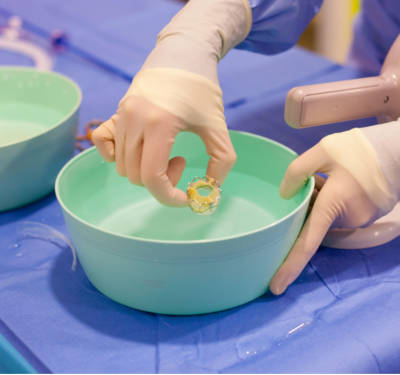Biomarkers show promise for treatment of heart valve disease
Certain biomarkers could play a role in the diagnosis and treatment of patients with narrowed, calcified heart valves.
Published online 31 December 2015

Valve replacement is often recommended in cases of severe narrowing of the aortic valve.
© Phanie / Alamy Stock Photo
Many substances involved in calcification, inflammation, and collagen breakdown and formation can be used to diagnose and potentially prevent the progression of heart valve narrowing, suggests a study published in Global Cardiology Science & Practice1.
The body’s main blood supply comes from the aorta, which receives oxygenated blood from the left ventricle of the heart. More than 2% of people over the age of 65 are afflicted with a narrowing and calcification of the valve that separates this main artery from its heart chamber. The condition, called calcified aortic valve stenosis (CAVS), leads to a reduction in the amount of oxygenated blood that reaches the body and can eventually lead to heart failure. There are currently no effective preventive therapies for the disease, and patients with severe narrowing of the aortic valve are recommended to opt for valve replacement.
Researchers in Greece analysed diseased aortic valve tissue and the serum of 60 CAVS patients undergoing aortic valve replacement. They then compared the levels of a large number of substances between CAVS patients and healthy participants.
They found, for example, very high levels of a chemical called tumour necrosis factor alpha (TNF-α), which is secreted by the cells of the immune system and stimulates inflammation. This, they suggest, could warrant research into the effects of anti-TNF-α treatments for CAVS patients. Anti-inflammatory treatments have, so far, been largely disappointing in heart failure studies, they caution.
They also found that levels of sclerostin, a signalling protein involved in inhibiting bone formation, were four times higher in the serum of CAVS patients. Previous research has found that patients with aortic calcification also show bone demineralization and inflammation and that sclerostin might play a role in suppressing the progression of vascular and probably valvular calcification.
Also, relaxin-2, which plays a role in inhibiting calcification and in promoting the preservation of elastin, a component in the body’s connective tissue, was found to be negatively correlated with aortic calcification. The team believes it could be a pertinent biomarker and a possible treatment option in early aortic calcification.
The effect of CAVS on serum levels of several substances that promote and inhibit calcification could guide the choice of replacement valve used in patients, say the researchers. For example, previous studies have shown that replacement valves originating from animal tissue (bioprostheses) become calcified in patients with increased levels of a type of low-density lipoprotein particles. The researchers suggest that patients with increased pro- or decreased anti-calcific factors in their serum should avoid replacement with a bioprosthesis.
The team is currently in the process of measuring the serum levels of biomarkers in patients six months after valve replacement. They are also comparing the levels of valve tissue markers with microRNAs and toll-like receptors, proteins involved in the immune system, in experimentally produced aortic stenosis in rabbits.Reference
- Kapelouzou, A. et al. Serum and tissue biomarkers in aortic stenosis. Glob. Cardiol. Sci. Pract. (2015).| article
DOI: 10.1038/qsh.2016.92

